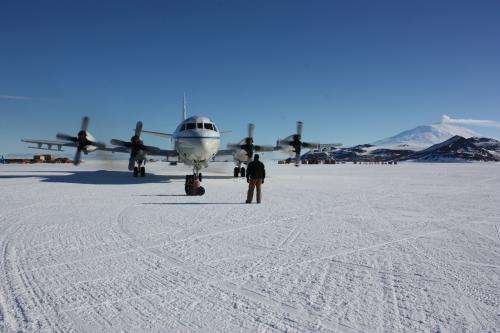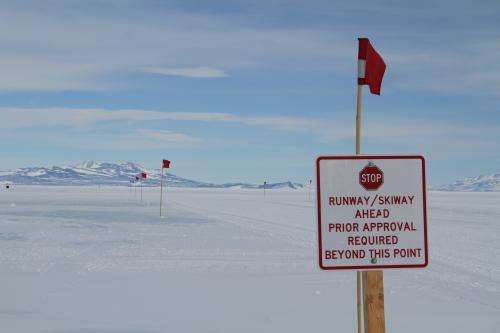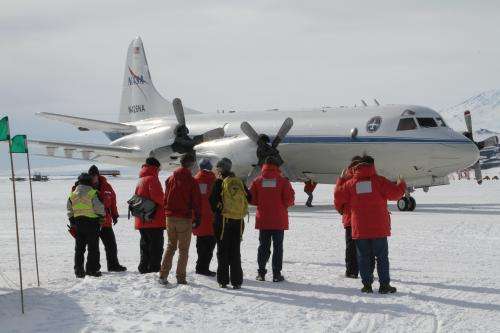NASA flight engineer Brian Yates directs the P-3 research aircraft during engine startup on the ramp at McMurdo Station's sea ice airfield before the Nov. 20 survey flight over Victoria Land. To the right in the background the nearby volcano Mount Erebus is venting a plume of steam. Credit: NASA / George Hale
Pilots and flight engineers with NASA's Operation IceBridge traveled to Jacksonville, Fla., to prepare for the mission's recently concluded Antarctic campaign. There the flight crews spent time training in a P-3 aircraft simulator at the U.S. Navy base Naval Air Station Jacksonville.
Each year, NASA pilots are required to train in a simulator and demonstrate proficiency in an actual aircraft, a process known as a check ride. Though this is only required once annually, many pilots train more frequently. "Typically we do more than that," said Mike Singer, a P-3 pilot at NASA's Wallops Flight Facility in Wallops Island, Va.
A warning sign at McMurdo Station's sea ice runway, prior to the first landing of NASA's P-3 aircraft in support of Operation IceBridge.
This year's additional training gave the pilots and flight engineers deploying to Antarctica with IceBridge the chance to work through several in-flight scenarios and practice taking off and landing from the sea ice runway at the National Science Foundation's McMurdo Station in Antarctica. This training is possible thanks to an agreement with the U.S. Navy that lends NASA time in the simulator.
IceBridge's mission planners, in concert with the aircraft office at NASA Wallops, came up with a detailed training plan to ready flight crews for the challenging Antarctic environment.
Planes carrying researchers, support personnel and cargo take off and land on a 10,000-foot-long (3,000-meter-long) runway built on thick sea ice in McMurdo Sound. Every season, engineers with the U.S. Antarctic Program's Antarctic Support Contract construct and maintain this runway, which can handle large transport aircraft like the U.S. Air Force's C-17.
A warning sign at McMurdo Station's sea ice runway, prior to the first landing of NASA's P-3 aircraft in support of Operation IceBridge. Credit: NASA/Jefferson Beck
In the simulator, NASA pilots are able to safely practice takeoffs and landings on a slippery surface like McMurdo's runway by turning the simulator's braking effectiveness down to zero. "You have no nose gear steering or braking power on ice," said Singer. "All maneuvering is done with engine power and rudder."
This reliance on engine power means it's vital that the crew be prepared to handle an engine problem. The P-3 has four propeller-driven engines, two on each wing. Having to shut down one or two of the plane's engines would make takeoffs, landings and ground maneuvers more challenging.
This is because of both reduced engine power and because propellers exert a force on the aircraft in the opposite direction that the propeller spins. Normally the forces from all four propellers cancel each other out, but the loss of an engine would cause the plane to yaw, or move to the left or right. This effect is more pronounced when engine power is high and when the wings are at a high or low angle from horizontal, such as during takeoff and landing.
Pilots can compensate for these imbalances with aircraft controls, and training in a simulator allows the flight crew to safely run through a variety of emergency scenarios. In most cases the flight engineer would be the first to notice an engine problem, which is why it's crucial for both pilots and flight engineers to practice working as a team. "If you fly together you need to train together," said Singer.
While pilots practice takeoffs and landings, flight engineers practice working with the aircraft's engines, electronics and other equipment. "The flight engineer monitors all aircraft systems," said Brian Yates, NASA P-3 flight engineer. "Our job is to give the pilots advice and back them up so they can concentrate on flying the plane."
Members of the IceBridge team greet the NASA P-3 after its first landing on McMurdo Station’s sea ice runway. Credit: NASA / Jefferson Beck
In addition to taking off, landing and maneuvering on McMurdo's sea ice runway, pilots and flight engineers needed to be prepared for approaches and landings relying solely on the aircraft's instruments. Weather in the Antarctic can change quickly and making an accurate forecast is challenging due to the lack of weather satellite coverage in the area.
To better prepare for this, NASA made several upgrades to the P-3's onboard systems that will improve the pilots' ability to make instrument approaches. But with these improvements come changes in the layout of displays in the aircraft. Getting used to the new layout takes time, which the flight crew was fortunately able to get.
In September, the P-3 and its crew deployed to Houston, Texas, as part of NASA's DISCOVER-AQ mission. The routine flights to gather air quality data gave pilots and flight engineers a chance to get used to these upgraded systems in more benign conditions. "We weren't just training in a simulator," said Singer. "We were getting experience with the real system."
Regular training, both in simulators and aircraft, is vital for keeping pilots and flight engineers up to date. "Simulator training is a good time for us to stay sharp on skills and practice emergency procedures," said Yates. "We like to take every opportunity we can to use this valuable resource."
Provided by NASA
























